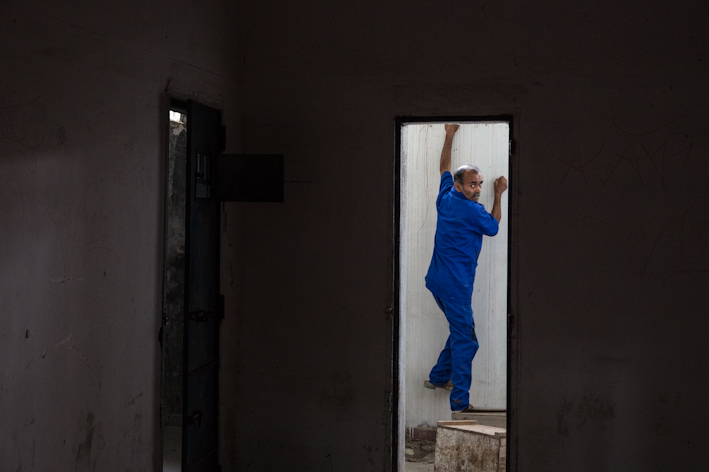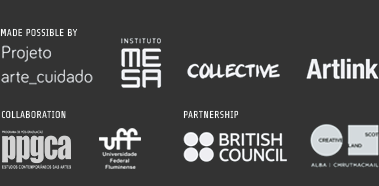
Arlindo. Trêsformance [Threeformance]. Performance in the old cells of Pavilion 10 at the Colônia Juliano Moreira on the occasion of the International Meeting: Care as Method # 2 on October 4, 2017. Photo: Denise Adams
Arlindo, The artist
Ricardo Resende
What defines the artist and what does not? Who defines what is art and what is not? Arlindo defines himself as an artist. A long-standing artist of Ateliê Gaia – a collective studio of resident artists, all former interns of the psychiatric asylum complex Colônia Juliano Moreira, in the northwest of Rio de Janeiro. Arlindo has frequented Ateliê Gaia – this place of creation and conviviality – for near on thirty years.
Asked why he makes art, he justifies it saying he makes art to please children. Although a mature man, he thinks with the innocence and malice of a child.
In a first moment of contact, I encountered a surly Arlindo, sullen, suspicious of our intentions. Defiant, he would not allow people to question or photograph him or even touch his works without his authorization. And, much less, without saying why, not even photograph his work. Yes, in the case of Arlindo one can say “work”. He has an enormous amount of work organized in a large room of Ateliê Gaia’s studio space. This set of pieces, understood as that of an authorial accumulator, could be a procession by the artist Nelson Leirner.
More than three years have passed since that first contact, in which he confronted me, as the then newly appointed curator (2014) of the Museu Bispo do Rosário Arte Contemporânea (Bispo Rosário Museum of Contemporary Art), in a rather demanding and challenging tone, asking: Why Bispo and not me?
This made us pay even more attention to the artist who, over time, has shown himself to be an attentive, caring and professional person. He has in mind artistic proposals, not just selling his work, but a desire to also constitute a body of work.
Arlindo collects discarded materials in the neighborhood streets of Curicica and Taquara that he then resignifies. Colônia Juliano Moreira has been his natural environment since he was hospitalized here as an adolescent. Since then, a lot has changed. Or better, Arlindo has transformed, changing with and through art. Today he is a more tranquil, conciliatory, conscientious man who demands his space, his rights and fulfills his duties. He is an artist.
He has responsibilities to the world and his colleagues. Recently, he has been absorbing what he has being seeing and experiencing in the programs of the Museu Bispo Rosario Arte Contemporânea (mBrac). Here I am particularly referring to the exhibition “Das Virgens em Cardues e a Cor das Auras” [Of Virgin Shoals and the Color of Auras] 2016, curated by Daniela Labra. After seeing the numerous performances and actions that took place over the course of this exhibition that had as its conceptual framework the proposal to explore the work of Arthur Bispo do Rosário as a grand life performance, Arlindo proposed a performance in which he would incorporate the figure of Bispo. The Art_Care project and the International Encounter: Care as Method # 2 was an opportunity to see this unfold. So we proposed to Arlindo that this might be the occasion to present his performance inspired by Bispo do Rosário. The environment would be his old cell. The artist had been incarcerated next door to Bispo’s cell in the former part of the psychiatric asylum reserved for violent schizophrenics known as the Ulisses Viana Pavilion.
Arlindo tells us about this conviviality when he is willing. Bispo was not a man of many words. Kind of withdrawn. Arlindo in a way embodies this figure today.
So, here came the possibility of inviting him to perform in the cell where they had lived for decades, side by side. Arlindo outdid himself. He surprised us with his rich, choreographed and well-paced performance. Some were deeply moved. Others disturbed by that strong experience. Realistic. And dramatic. Arlindo surpassed himself as an artist who re-signifies discarded materials transformed into airplanes, police cars, human figures, animals, cemeteries, and coffins of the deceased – he has a real fixation for these themes.
Arlindo, in this process of transformation provoked by Art, is other in the extraversion, so much so that he can be in front of an audience, performing, acting himself. Representing, as such, madness. Retaking his place for himself. That he will never go back to being the same. After this enchantment of being an artist, Arlindo is the result.
The artist is the fruit of work that is free from the moorings of a guided art. Arlindo is today the freedom of creation.
Performance by Arlindo. Trêsformance. Film by Daniel Murgel, 2017. Record of performance by Arlindo in the Pavilion 10 of the Colony Juliano Moreira on October 4, 2017 as part of the International Meeting: Care as method # 2. Original length 40 minutes.
***
Arlindo Oliveira da Silva
The artist creates sculptures using various techniques and supports such joining elements like wood, lights, clothes, toys and other objects collected in the territory where he lives and works. Since 2017 he has developed performances that relate to his experience as an intern in a mental institution. For almost 30 years he has been a resident artist at the collective studio Atelier Gaia, a program of the Bishop Museum of Rosario Arte Contemporânea (mBrac) for former asylum interns, now coordinated by Diana Kolker. At mBrac Arlindo has participated in the exhibitions: Quilombo do Rosario, curated by Roberto Conduru (2018); Sobrevivências: Sobre Vivências, curated by Ricardo Resende (2017); Play, curated by Marta Mestre and Fernanda Pequeno (2013). In 2017, he participated in the exhibition Constelar, curated by Marcelo Campos, at the Pro-Saber Institution. He also participated in the exhibition Lugares do delírio, curated by Tania Rivera, in the Museum of Art of Rio (2017) and SESC Pompeia, in São Paulo (2018) resulting in his work being acquired for MAR’s collection. He was recently one of the artists selected for the Bienal Naif, held in 2018, by SESC Piracicaba.
Ricardo Resende
Ricardo Resende is currently curator of the Bispo Rosário Museum of Contemporary Art, Rio de Janeiro. Prior to this he was the general director of the São Paulo Cultural Center from 2010 to 2014. He holds an MA in Art History from the School of Art and Communications of the University of São Paulo (USP). He is the author of the first book about the artist Hudinilson Urbano Jr., (1957-2013) Posição Perigosa, with the support of Itaú Cultural.
____________




![<I>O seresteiro no espaço do Arlindo no estúdio Ateliê Gaia</i>. [The Seresteiro in Arlindo's Studio Space at Atelier Gaia]. Photo: Diana Kolker](https://institutomesa.org/revistamesa/edicoes/5/wp-content/uploads/2018/12/2-13.jpg)

![Arlindo. <i>Navegar</i> (várias obras) [Navegate (various works)] 2017. Wood, plastic, thread and string. Photos: João Oliveira](https://institutomesa.org/revistamesa/edicoes/5/wp-content/uploads/2018/12/6-6.jpg)
![Arlindo. <i>Navegar</i> (várias obras) [Navegate (various works)] 2017. Wood, plastic, thread and string. Photos: João Oliveira](https://institutomesa.org/revistamesa/edicoes/5/wp-content/uploads/2018/12/5-10.jpg)
![Arlindo. <i>Navegar</i> (várias obras) [Navegate (various works)] 2017. Wood, plastic, thread and string. Photos: João Oliveira](https://institutomesa.org/revistamesa/edicoes/5/wp-content/uploads/2018/12/4-11.jpg)
